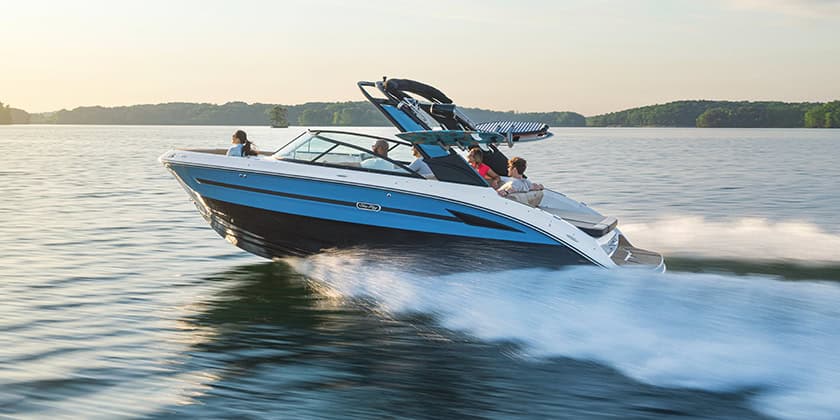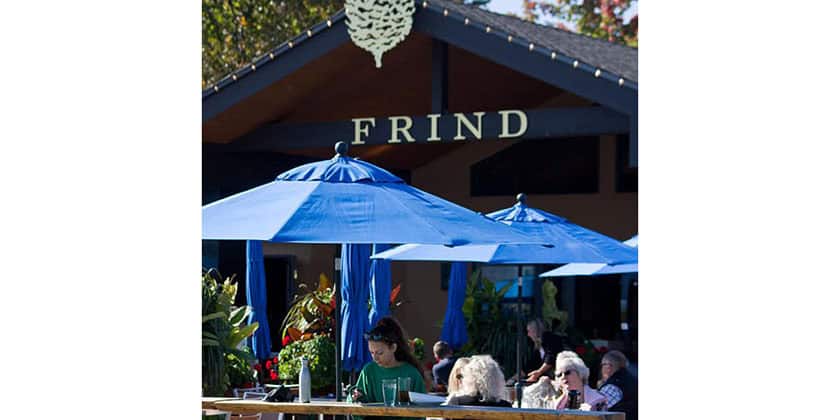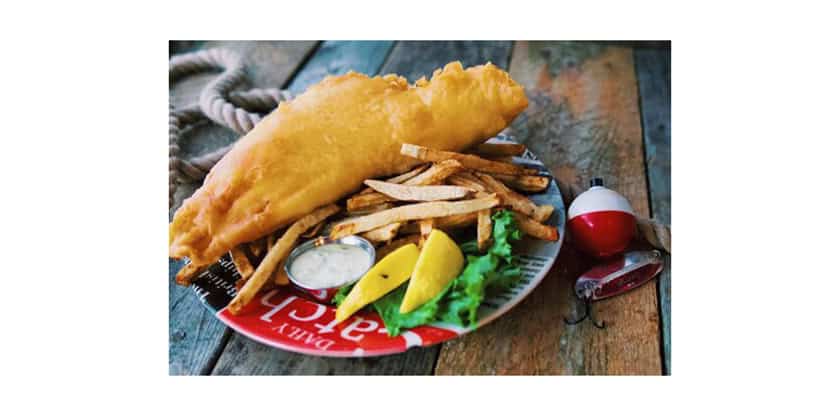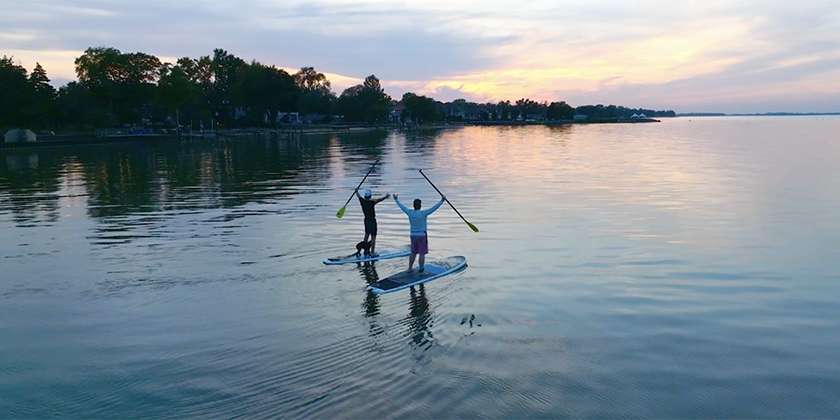Jeanneau Sun Odyssey 410
By, Zuzana Prochazka
The revolution continues – with a twist
The Jeanneau 410 is the eighth generation of the Sun Odyssey line, but even with that long history and umpteen years of tweaks and iterations, what the French builder has done in the latest revamp will make you say, “Wait, what?”
Last year, Jeanneau turned the sailboat deck layout on its ear with the introduction of their Sun Odyssey 490 and 440, and the concept of the ‘walk-around deck’. Now, these topsides have made their way to the new 41-footer. In case you think it’s all the same stuff in a smaller package, know that designer Marc Lombard threw in a few creative features to make things interesting on this, the third model to join the new French revolution.
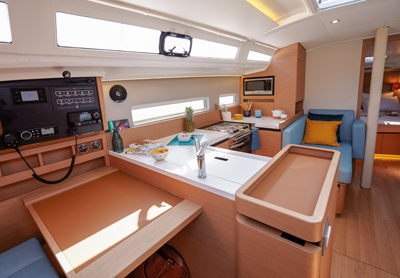 It’s always good to see a proper navigation desk on a production boat.
It’s always good to see a proper navigation desk on a production boat.
Design
The most notable new distinction is the inverted or “negative” bow. Not only is the stem raked slightly aft at deck level, but also the foot of the bow has a bit of rocker so it clears the water by a few inches. That should reduce drag in light winds. Some may say it’s purely for aesthetics – and maybe so – but it sure makes the 410 look like a racing rock star.
A hard chine runs the length of the hull down low to help keep her on her feet in a blow and her maximum beam is brought all the way aft. Twin rudders keep her maneuverable even when heeling, and a powerful, retractable bow thruster provides confidence in close quarters. Forward is an optional integrated composite bowsprit that adds an attractive elongation to the hull as well as a place to stow the anchor and attach a gennaker. All in all, this model is built for speed and is easy on the eyes.
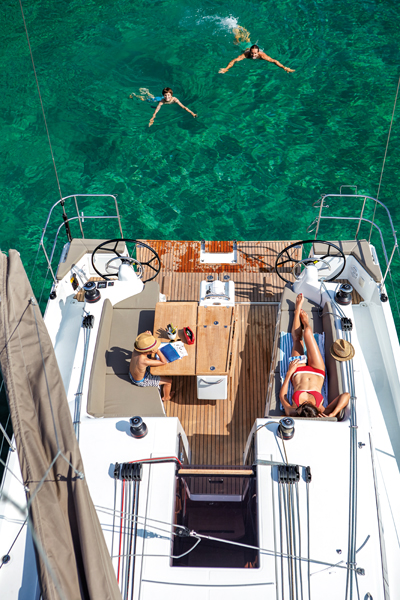 The drop-down transom extends the cockpit for easy movement and provides a great teak beach at the same time.
The drop-down transom extends the cockpit for easy movement and provides a great teak beach at the same time.
On Deck
Standing at one of the twin wheels, you can walk all the way to the bow without stepping or climbing over anything, least of all a cockpit coaming. You can then walk all the way aft down the other side and arrive at the other wheel with no obstacles. The deck slopes gently up and onto the main side deck. Drains by the pedestals are there to gather up any water spraying up over the bow and rushing down toward the driver. Best of all, you can drive facing forward, which will be appreciated by anyone who has had to crane their neck for hours on a long watch.
Nice bullwarks all around provide a foothold when heeling, and there are no jib tracks to stub your toes on due to the use of friction rings on the headsail sheets. With the various packages available, Jeanneau ensures the 410 has numerous options to suit any style of sailing. The standard version inlcudes a tradititional hoist mainsail and a 115% genoa, but you can also get in-mast furling and a self-tacking jib with a track just ahead of the mast. This plus a Code 0 makes perhaps the best combination for easy, short-handed sailing on any point of sail.
The double-spreader, fractional Z-spar rig carries 865 square feet of Technique Voile sails. The optional performance pack adds 11 inches to the mast, laminated sails, an adjustable textile backstay, and composite wheels. The cathedral rig, with the lower D1 and cap shrouds terminating at different chainplates (one on the outside and one on the coachroof) keeps the side decks clear so it’s easier to walk from the wheel to the bow. A nice touch is that the boom has been lowered so you can now manage the sail in the bag without having to climb in.
 The inclined decks also mean you can drive facing forward when seated a much more comfortable position for long watches at the helm.
The inclined decks also mean you can drive facing forward when seated a much more comfortable position for long watches at the helm.
Unlike the 440, the 410 doesn’t have a fold-out cockpit coaming so the Harken winches are outboard and just ahead of the wheels, rather than inboard on pedestals. That makes them easier to reach for the driver but not as well positioned as on the 440, where crew can stand behind them and grind while looking at the sail ahead. There are excellent handholds at the wheels, and liferaft stowage as well as the emergency tiller attachment are below the cockpit sole between the helms.
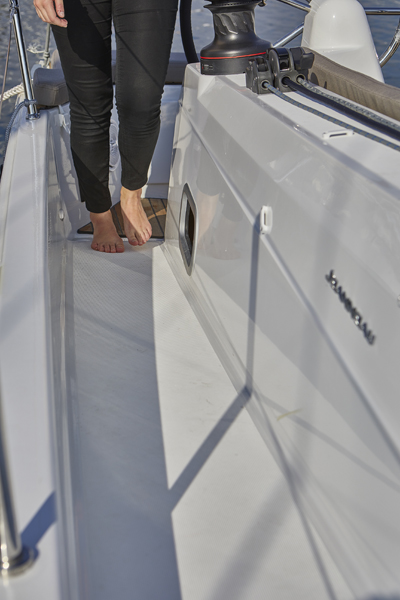 No more climbing over the cockpit coaming. The walk-around design makes it easy to traverse from the helm to the side deck and all the way forward.
No more climbing over the cockpit coaming. The walk-around design makes it easy to traverse from the helm to the side deck and all the way forward.
Versatile Accommodations
The 410 can be configured with two or three cabins and one or two heads. The interior is the work of Jean-Marc Piaton, a designer new to the Jeanneau team, and he’s added a few out-of-the-box thoughts. One example is the “day bed” in the saloon. Positioned on the centreline just aft of the compression post, this versatile lounge does three things: It extends aft to add seating to the fold-out dinette, it forms an additional sea berth with stowage below, and in its natural state, it’s a cozy lounge that would be my go-to spot when off watch.
The master stateroom has a choice of a bed offset on the diagonal (to make room for an en suite head) or on the centreline in case a single head is spec’d. I’d opt for the latter, since the forward head is shoehorned in and small, and although Jeanneau insists there’s a separate shower stall, I’d beg to differ. The berth is square so household sheets can be fitted and there’s copious stowage throughout.
The galley seems to have gained respect and it has stolen real estate from the saloon. Twin sinks, an Eno stove with dual burners and oven, and Vitrifrigo refrigeration are standard. An additional freezer drawer can be added to the aft port cabin, especially when it’s used as a utility room in the two-cabin version. Water tankage is 87 gallons but a second 53-gallon tank may be added.
A splash screen separates the galley from the forward-facing nav desk. I’m happy to see real navigation stations on production boats because no matter how much is done with electronic cartography these days, it’s still important to have a dedicated space for ship’s business.
Digital switching by Scheiber eliminates the need for a large electrical panel. However, if you have a completely dead ship (as we did when we arrived on the dock on test day), it’s good to know that the optional 7.5 kW Onan genset (positioned behind the engine) has a manual override so you can set about charging with both the engine and the generator to fill the house batteries quickly.
Fabric-covered bulkhead panels help with sound attenuation and the Alpi wood finish is available in either teak or grey cedar. Headroom in the galley is 6’3” and in the saloon,
6’5” – even taller boaters will feel right at home.
Performance
Like many boat outings, our test day was a mix of good and bad. It was nice to be on the flat waters of the Chesapeake, but the wind gods were busy elsewhere and we had a breeze that occasionaly gusted to nine knots. Still, we managed to have fun and point high. At 35 degrees apparent wind angle, we squeezed out 5.2 knots in nine knots of true breeze. When we cracked off to 120 degrees, we still carried 3.7 knots of boat speed and then we came back up to five knots at 65 degrees as the puffs grew few and far between. With the thoughtful cockpit layout, it’s feasible to tack the boat single-handed without an autopilot and not get flustered.
 The galley layout offers good bracing points so you can cook on passage in relative safety.
The galley layout offers good bracing points so you can cook on passage in relative safety.
The Sun Odyssey is powered by a 40-hp Yanmar common rail diesel and shaft drive with a three-blade fixed propeller, which are upgradable to a 45-hp engine and a Flexofold folding prop. With the smaller engine and standard prop, we motored at 6.2 knots at 2,100 rpm and 7.9 knots at wide-open-throttle at 3,100 rpm. The boat backed straight as an arrow but took about two boat lengths to turn, which may be where that bow thruster would come in handy.
Overall Impressions
Jeanneau has built 18,000 similar yachts with continuous improvements; it’s nice to know they’re not resting on their laurels. As the new deck design proliferates throughout the Sun Odyssey offering, the company is still adding twists and incremental improvements. Some of these changes may no longer be truly revolutionary, but these evolving French models can still say, “Let them eat cake.”
Specifications
LOA: 40’6″ (12.35 m)
Beam: 13’1″ (3.99 m)
Draft: 7’0″. 5’2” (2.14 m)
Displacement: 17,417 lbs. (7,900 kg)
Sail Area: 865 sq. ft. (80.3 sq. m)
Fuel: 53 gallons (200 l)
Water: 87 gallons (330 l) + 53 gallons (200 l)
Engine: Yanmar 40 hp or Yanmar 45 hp
Designer: Marc Lombard
Builder: Jeanneau Yachts










